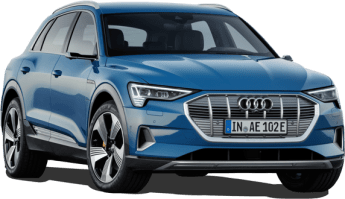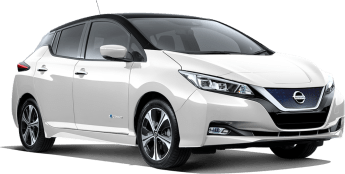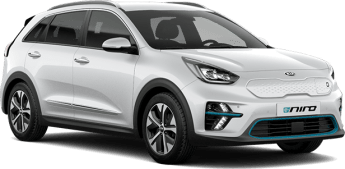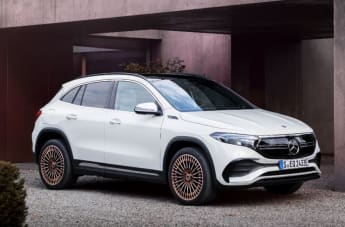They’re coming. Slowly but surely, battery-electric vehicles (BEVs, or EVs) are making their way to Australia, despite the lack of federal, state and local government incentives that help boost the demand for zero-tailpipe-emissions vehicles.
The fact is, EV infrastructure is growing from coast to coast, and carmakers remain confident that legislators will eventually join other nations in incentivising EV uptake in some form or another. After all, we are on the cusp of huge wave of fresh EVs, especially from Europe, Korea and China.
We’ll only see a trickle initially, but some are already earmarked for an Australian launch in 2021.
Best electric cars arriving in 2021
- 01. Volvo XC40 Recharge Pure Electric - Third quarter
- 02. Audi e-tron S - Second half
- 03. BMW iX3 - Mid-2021
- 04. Nissan Leaf e+ - April
- 05. Hyundai Ioniq 5 - Third quarter
- 06. Hyundai Kona Electric - April
- 07. Mazda MX-30 Electric - August
- 08. Lexus UX300e - November
- 09. BMW iX - Fourth quarter
- 10. Kia e-Niro - May
- 11. Mercedes-Benz EQA - July
- 12. Mini Cooper SE - April
- 13. Polestar 2 - November
- 14. Other new models coming in 2021
- 15. New models arriving in 2022
01. Volvo XC40 Recharge Pure Electric - Third quarter

Hot on the heels of the Volvo XC40 Recharge Plug-in Hybrid and due in the third quatyer of 2021, the Recharge Pure Electric employs a 300kW/660Nm dual-motor powertrain and a 78kWh lithium-ion battery that provides more than 400km of range.
Driving all four wheels, the Swedish SUV can hit 100km/h in 4.9 seconds, while a DC fast charger can replenish the battery pack from flat to 80 per cent in 40 minutes.
You’ll spot the electrified Volvo from its closed-off grille, unique wheels, ‘Recharge’ badging peppered around the body and interior. There’s also a 30L frunk due to its lack of an internal-combustion engine.
Volvo XC40
Based on Manufacturer's Suggested Retail Price (MSRP)
02. Audi e-tron S - Second half

The ‘S’ in e-tron S stands for sport, meaning it is the performance version of the Ingolstadt company’s first dedicated EV. We’re talking different bumpers with larger air intakes, bigger alloy and wider wheelarches.
Due in the second quarter of 2021 in both wagon and coupe-style Sportback body-styles, the e-tron S features three electric motors, delivering up to 370kW and 973Nm in ‘overboost’ mode, for a 0-100km/h streak of just 4.5 seconds. Conversely, with a 95kWh battery, nearly 360km (WLTP) of driving is possible and a 150kW DC fast charger can replenish to 80 per cent in about 30 minutes.
Sports suspension with adaptive dampers and air springs, bolstered seating and Nappa leather further underline the e-tron S’ performance bend.
Audi E-Tron

Based on Manufacturer's Suggested Retail Price (MSRP)
03. BMW iX3 - Mid-2021

Built in China and heavily based on the latest X3 SUV, the iX3 will launch locally in mid-2021, with a single-motor, 210kW/400Nm set-up, for a zero to 100km/h time of 6.8 seconds and 180km/h top speed.
Other key stats are an underfloor 80kWh battery for 460km of driving range (WLTP), up to 80 per cent recharging in 34 minutes using a (still rare) 150kW DC fast charger, while dual-motor versions with higher outputs and all-wheel drive are expected a little later on.
Trainspotters will differentiate iX3 from regular X3 via the former’s aerodynamically honed grille insert and bumpers, restyled alloys and circa-75mm lower ride height.
BMW IX3

Based on Manufacturer's Suggested Retail Price (MSRP)
04. Nissan Leaf e+ - April

The long-awaited e+ variant of the Nissan Leaf landed in April with boosted range and performance.
The e+ adds 50kW/20Nm (total: 160kW/340Nm) and a 62kWh lithium-ion battery (+22kWh) for a substantial 115km of extra range (to 385km, WLTP), eclipsing those of the Hyundai Ioniq Electric. It’s also 0.6 seconds faster to 100km/h, at 7.3 seconds.
On the flipside, the bigger batteries mean 11.5 hours (+4 hours) to charge from 20 to 80 per cent using an optional 7kW AC wallbox, but a 50kW DC fast charger cuts that to 90 minutes.
Nissan LEAF

Based on Manufacturer's Suggested Retail Price (MSRP)
05. Hyundai Ioniq 5 - Third quarter

In the third quarter of 2021, we'll see Hyundai's "re-birthed" Ioniq as an EV sub-brand, spearheaded by the pretty, new Ioniq 5 mid-size SUV.
A production version of the 45 concept revealed at the 2019 Frankfurt motor show, it will ride on Hyundai's Electric Global Modular Platform (E-GMP), shared with sister brand Kia. Beyond the general shape, it will bring "fast charging capability and plentiful driving range", according to a statement.
Furthermore, E-GMP allows the Ioniq 5's interior to be "reimagined" as a "smart living space", with features such as drawers for a glovebox.
Hyundai Ioniq

Based on Manufacturer's Suggested Retail Price (MSRP)
06. Hyundai Kona Electric - April

Hyundai launched a facelifted version of its acclaimed Kona Electric EV in April.
You’ll spot it by its newly smoothed-out nose featuring sleeker lighting and a grille-less look, while the plastic cladding around the bumpers and wheel arches are now body coloured for a more upmarket appearance.
Predictably, the updated central touchscreen is now larger, the instrumentation cluster is a revamped 10.25-inch digital set-up, and ambient cabin lighting elements have been introduced. Safety gains include active blind-spot monitoring, rear cross-traffic alert, Leading Vehicle Departure Alert, Safe Exit Warning and Rear Seat Alert.
While the Kona Electric continues with a 64kWh battery and 150kW/395Nm electric motor that drives the front wheels, tyre improvements have boosted the WLTP range by 35km, to 484km.
Hyundai Kona

Based on Manufacturer's Suggested Retail Price (MSRP)
07. Mazda MX-30 Electric - August

Mazda will enter the electrified car market in August with the eagerly anticipated MX-30 Electric small SUV.
The EV has a front-axle-mounted 107kW/271Nm electric motor and a “right-sized” 35.5kWh battery pack that offers 224km of range as well as comparatively fast charging. A range-extender MX-30 with the battery charged by a tiny rotary engine is expected in 2022.
Aiding the eco cause are sustainable cabin materials such as cork, recycled plastics and synthetic leatherette, while Mazda RX-8-style forward-opening rear doors provide some dramatic visual flair.
Mazda MX-30

Based on Manufacturer's Suggested Retail Price (MSRP)
08. Lexus UX300e - November

Luxury hybrid specialists Lexus is releasing its first EV in Australia in November with the UX300e.
Powered by a 150kW/300Nm electric motor driving the front wheels, it can hit 100km/h in 7.5 seconds, while a 54.3kWh battery provides 400km of NEDC driving range and can be fast charged in about 50 minutes.
More information, including pricing and aftersales care details, will be announced closer to launch, but Lexus says the UX300e will be the “performance flagship” of the popular premium small SUV series, so should sit above the current range-topping petrol-electric UX250h F Sport (from $64,000 plus on-road costs).
09. BMW iX - Fourth quarter
.jpg)
BMW will take on the Tesla Model X with the all-new iX SUV, as the brand’s EV flagship in Australia, joining the coming i4 sedan and iX3 SUV in its new electric pantheon.
Slated for the fourth quarter of 2021, the German crossover is dimensionally close to the X6, but sits on the brand’s fifth-generation eDrive electric drivetrain. The latter includes a 112kWh battery good for 630km of WLTP range.
Other key points include two electric motors for 385kW of power combined for a 4.6-second 0-100km/h dash and extensive use of carbon-fibre for lightness and strength. Ever-expanding displays and high-tech features “which only reveal themselves when being used” distinguish BMW’s latest EV inside.
BMW IX3

Based on Manufacturer's Suggested Retail Price (MSRP)
10. Kia e-Niro - May
_0.jpg)
The small SUV seems to be the hottest segment for all-electric models, with Kia launching its e-Niro competitor in May.
Sharing its underpinnings with the Hyundai Kona, the e-Niro uses a 64kWh battery pack for a range of around 385kW, while the electric motor outputs 150kW/395Nm.
Kia Niro

Based on Manufacturer's Suggested Retail Price (MSRP)
11. Mercedes-Benz EQA - July
_0.jpg)
The smaller sibling to the EQC mid-size SUV, Mercedes-Benz's EQA small crossover will launch in July at a price of $76,800 before on-road costs.
The EQA uses a 140kW/375Nm electric motor to drive the front wheels, paired with a 66.5kWh battery to deliver 480km of driving range.
Inside, the EQA is very much a Mercedes thanks to its MBUX dashboard, while the outside is decked out with 19-inch wheels and LED lighting all round.
Mercedes-Benz EQA

Based on Manufacturer's Suggested Retail Price (MSRP)
12. Mini Cooper SE - April

Mini doubled down on its electric Cooper SE in April, expanding the line-up of its all-electric hatchback with the Classic and Mini Yours trim levels.
Pricing did go up, though, but was somewhat justified with more standard equipment, such as piano-black trim, a wireless smartphone charger, a Nappa leather steering wheel and a digital instrument cluster.
The powertrain carries over as before, though, which is a 135kW/270Nm electric motor and 32.64kWh battery good for around 233km of range.
13. Polestar 2 - November
.jpg)
Polestar's long-awaited arrival to the Australian market will finally happen in November 2021 with the launch of the 2.
Sporting a high-riding sedan body, the Polestar 2 promises both sporty dynamics and luxury appointments, and will be available across three flavours.
The base car will be good for around 440km of range, the mid-tier version about 540km, while the top-spec cuts it down to 480km thanks to a dual-motor set-up that prioritises performance over efficiency.
Polestar 2

Based on Manufacturer's Suggested Retail Price (MSRP)
14. Other new models coming in 2021
Want to know what other new models are arriving in 2021? Check out our rolling coverage below.
- The best new cars coming to Australia in 2021
- Best 4x4 and off-road vehicles arriving in 2021
- Best crossovers arriving in 2021
- Best hatchbacks arriving in 2021
- Best sedans arriving in 2021
- Best electric cars arriving in 2021
15. New models arriving in 2022
Want to know what new models are due in 2022? Check out our rolling coverage by clicking on the links below.
- The best new cars coming to Australia in 2022
- Best crossovers arriving in 2022
- Best electric cars arriving in 2022
- Best hatchbacks arriving in 2022
- Best 4x4 and off-road vehicles arriving in 2022
- Best sedans arriving in 2022




.jpg)



.jpg)





.jpg)


_0.jpg)


.jpg)
.jpg)

.jpg)


.jpg)



.jpg)
Comments